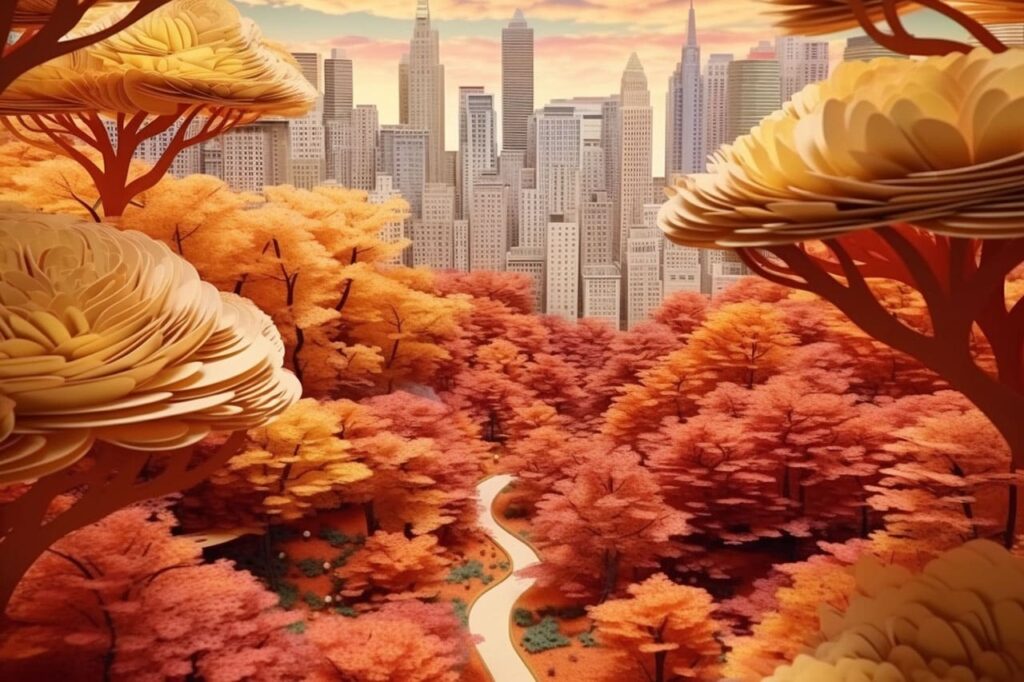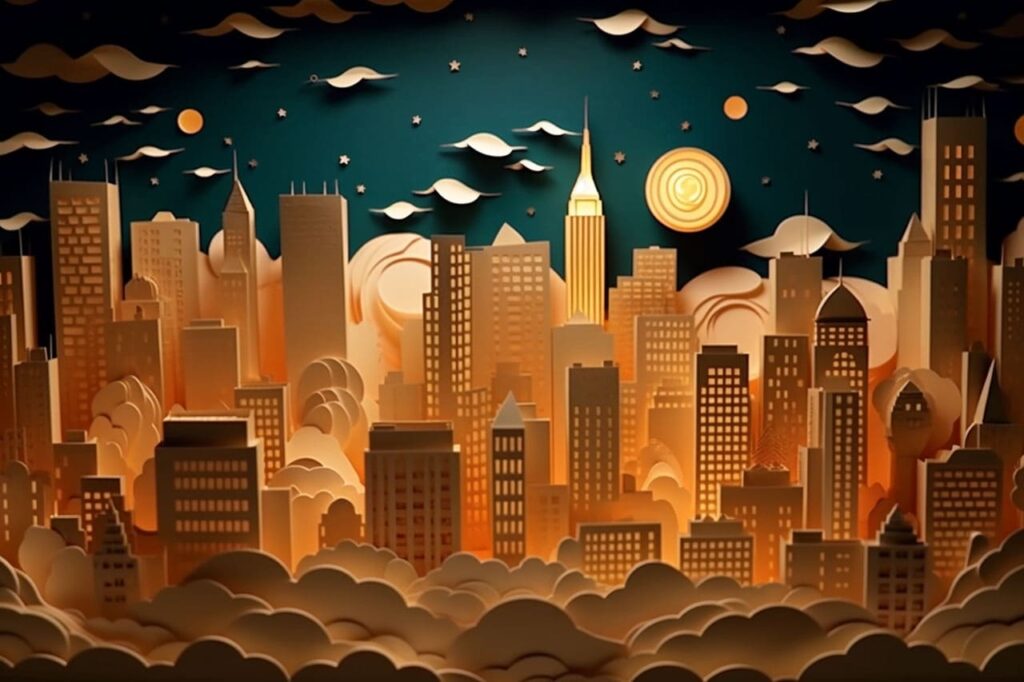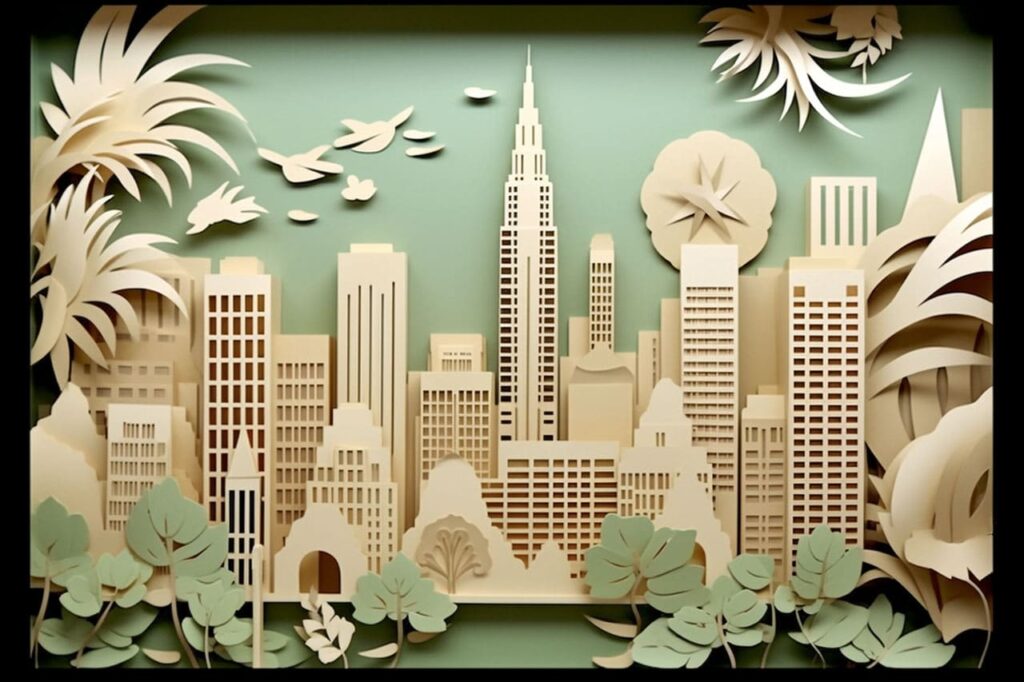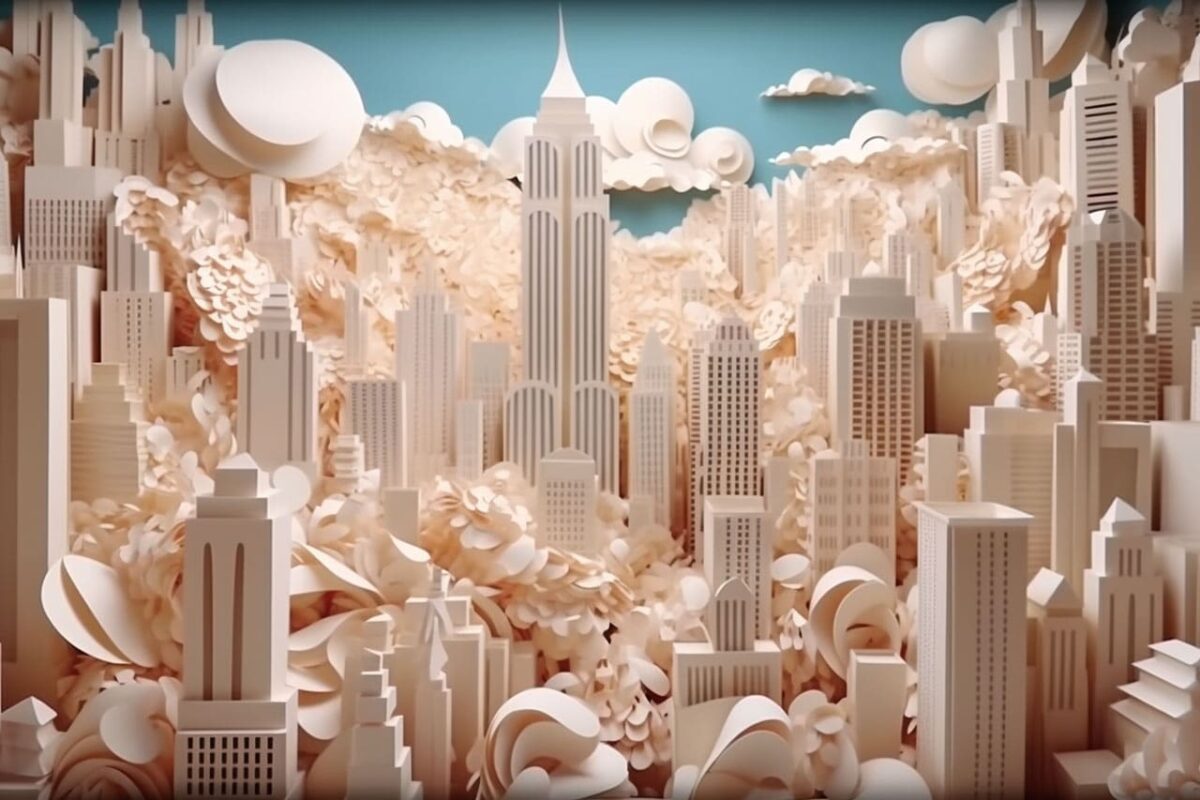A collection of imagined scenes from New York City, featuring paper-cutting (Kirigami). The scenes include the Brooklyn Bridge and Central Park in Autumn.






Inspiration for the Scenes
Manhattan
Artists are often drawn to capturing scenes from Manhattan, the iconic borough of New York City, for numerous compelling reasons. Manhattan, with its breathtaking skyline, diverse neighborhoods, and vibrant energy, offers a vast array of subject matter and inspiration for artists across different mediums.
One of the primary reasons artists love to depict Manhattan is its architectural marvels. The towering skyscrapers, such as the Empire State Building, One World Trade Center, and the Chrysler Building, create an awe-inspiring cityscape that is instantly recognizable. The interplay of light and shadow on these structures, combined with the bustling streets below, provides artists with a wealth of opportunities to explore and convey the dynamic essence of urban life.
Moreover, Manhattan’s diverse neighborhoods serve as a rich tapestry for artists to explore and portray. From the historic charm of Greenwich Village to the bustling streets of Times Square, each neighborhood possesses its own distinct character and ambiance. Artists can capture the unique architecture, street scenes, and cultural landmarks that define these neighborhoods, allowing them to convey the city’s vibrant multiculturalism and ever-evolving nature.
The city’s iconic landmarks, such as Central Park, the Statue of Liberty, and the Brooklyn Bridge, also serve as alluring subjects for artists. These landmarks have become enduring symbols of New York City and evoke a sense of grandeur and history. Artists strive to capture the essence and spirit of these landmarks, often highlighting their significance in the city’s cultural fabric.
Furthermore, Manhattan’s status as a cultural hub makes it a magnet for artists from around the world. The city is home to numerous art galleries, museums, and performance spaces, providing artists with a thriving artistic community and a constant source of inspiration. The diverse and eclectic art scenes, ranging from traditional to contemporary, foster creativity and innovation, encouraging artists to push boundaries and explore new artistic expressions.
Lastly, Manhattan’s frenetic pace and constant movement contribute to its appeal for artists. The city pulses with energy day and night, with people from all walks of life bustling through its streets. Artists are captivated by the dynamic and ever-changing nature of the city, which presents them with an endless array of subjects to capture—whether it’s a crowded subway platform, a street performer captivating a crowd, or a solitary figure navigating the urban landscape.
Brooklyn Bridge
Artists are often captivated by the Brooklyn Bridge, an architectural marvel and an iconic symbol of New York City, which has become a beloved subject for capturing scenes. Its majestic presence, historical significance, and aesthetic beauty make it a compelling inspiration for artists across different mediums.
First and foremost, the Brooklyn Bridge’s sheer grandeur and striking design make it an irresistible subject for artists. Its towering stone piers, graceful arched spans, and intricate cable network create a visually stunning composition that captures the imagination. The interplay of light and shadow on the bridge’s structure throughout the day and seasons adds depth and drama to artistic representations, allowing artists to explore the play of light and capture the bridge’s changing moods.
The historical significance of the Brooklyn Bridge also contributes to its appeal. Completed in 1883, it was one of the most significant engineering achievements of its time and remains an enduring symbol of human ingenuity and progress. Artists are often drawn to its rich history and the stories it tells. Depicting the bridge allows them to honor the past, evoke nostalgia, and celebrate the bridge’s role in connecting the boroughs of Manhattan and Brooklyn.
Furthermore, the Brooklyn Bridge’s location offers artists a wealth of scenic opportunities. Positioned over the East River, it provides breathtaking vistas of the Manhattan skyline and the surrounding waterfront areas. Artists can capture the bridge’s magnificent silhouette against the backdrop of the cityscape, offering a compelling juxtaposition of human-made structures and natural elements. The bustling pedestrian walkway and the flow of traffic on the bridge also offer dynamic elements that artists can explore, capturing the movement and energy of the city.
The bridge’s symbolism and emotional resonance further contribute to its allure. It represents the idea of connection, linking two vibrant boroughs and serving as a metaphorical bridge between past and present. Artists often find inspiration in capturing these themes, representing the bridge as a symbol of unity, aspiration, and the human spirit’s ability to overcome challenges.
Lastly, the Brooklyn Bridge’s enduring popularity as a cultural icon and tourist attraction provides artists with a sense of shared experiences and familiarity. It has been depicted in countless artworks, films, and photographs, becoming an instantly recognizable symbol of New York City. Artists may feel compelled to contribute their unique interpretations and perspectives, adding to the rich artistic legacy associated with the bridge.
In conclusion, artists love to capture scenes of the Brooklyn Bridge due to its grandeur, historical significance, aesthetic beauty, scenic opportunities, symbolism, and cultural resonance. Through their artistic renderings, they seek to convey the bridge’s captivating presence, evoke emotions, and immortalize its timeless allure in visual form.
Central Park
Artists are often enamored with capturing scenes of Central Park, an iconic green oasis nestled in the heart of New York City. Central Park’s vast expanse, natural beauty, and diverse landscapes make it a beloved subject for artists across various artistic disciplines.
One of the primary reasons artists love to depict Central Park is its sheer beauty and tranquility. The park’s lush greenery, meandering paths, serene lakes, and blooming gardens create a visual feast for artists. The changing seasons offer a rich palette of colors and textures, from vibrant spring blossoms to the fiery hues of autumn foliage. Artists are drawn to the park’s natural elements and the interplay of light and shadow that create captivating and evocative scenes.
Moreover, Central Park’s diverse landscapes and architectural features provide artists with a plethora of artistic possibilities. The park boasts rolling hills, picturesque bridges, cascading waterfalls, meadows, and densely wooded areas, each offering its own distinct charm. The juxtaposition of man-made structures, such as the iconic Bow Bridge or Bethesda Terrace, against the park’s natural elements offers artists intriguing compositions and opportunities to explore the interaction between urban and natural environments.
Central Park’s role as a gathering place for people from all walks of life also appeals to artists. The park teems with life—families picnicking, joggers and cyclists whizzing by, musicians performing, artists painting, and people simply seeking respite from the bustling city. Artists are captivated by the diverse array of human interactions and emotions that unfold within the park’s boundaries, providing a rich tapestry of subjects to capture, from intimate moments to grand celebrations.
Furthermore, Central Park’s historical and cultural significance adds to its allure for artists. Designed in the mid-19th century, the park has a rich heritage and has witnessed countless moments of New York City’s history. It serves as a stage for concerts, theater performances, art exhibitions, and community events. Artists find inspiration in the park’s role as a cultural hub, representing the intersection of art, nature, and human experiences.
The accessibility and popularity of Central Park also contribute to its appeal. It attracts both locals and visitors from around the world, making it a shared experience and a subject of universal recognition. Artists find joy in capturing the park’s familiar landmarks and scenes, adding their unique perspectives and interpretations to the collective artistic narrative surrounding Central Park.
In summary, artists love to capture scenes of Central Park due to its natural beauty, diverse landscapes, architectural features, human interactions, historical significance, and universal appeal. Through their artistic endeavors, they seek to convey the park’s enchanting qualities, evoke emotions, and celebrate the harmonious blend of nature and urban life that Central Park embodies.
(Note: see another artist’s interpretation of Central Park)
About Kirigami
Kirigami is a traditional Japanese paper-cutting art form that involves creating intricate designs by folding and cutting paper. The word “kirigami” is derived from the Japanese words “kiri” (which means “cut”) and “kami” (which means “paper”).
In kirigami, a single piece of paper is folded and then carefully cut to produce symmetrical patterns, shapes, or scenes. Unlike origami, which primarily focuses on folding paper without cutting, kirigami allows for the use of scissors or a craft knife to achieve more detailed and complex designs.
Kirigami can be used to create various types of artistic creations, including decorative paper ornaments, pop-up cards, paper sculptures, and even architectural models. The precision and skill required in kirigami make it a captivating and visually appealing art form that combines the elements of paper, design, and craftsmanship.
